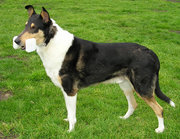Other Dog Training & Obedience
Obedience training involves training an animal, most often a dog, to obey basic control commands such as sit, down, and heel. more...
There are almost as many methods of training as there are trainers, but over time the basic strategy has shifted away from punishment or avoidance training (negative reinforcement) to positive reinforcement, where the dog is rewarded for doing the correct thing during most phases of training rather than being punished for not doing what the trainer wants.
History
Working dogs have always learned to obey commands related to the work that they historically performed, such as when a sheepdog moves a flock of animals in response to a shepherd's whistled directions, or a hunting dog searching for (or chasing down) quarry or leaving the treed quarry at the hunter's command.
It has been only in more modern times, as the dog has become more of a companion than a hired servant (paid in food and a dry place to lie down) who lived in the barn with other livestock, that obedience training has become a separate and specific skill (for both the owner and the dog).
In the twentieth century, formalized dog training originated in military and police applications, and many theories on how to train a dog came out of the same mentality that created boot camp for soldiers.
In the middle and late part of the century, however, more research into operant conditioning and positive reinforcement occurred as wild animal shows became more popular-- Traditional methods of teaching animals behavior (as with dogs) proved irrelevant when, for example, a trainer had to instruct a dolphin or an orca. These aquatic mammal trainers used clickers (a small box that makes a loud click when pushed on) to "mark" desired behavior, giving food as a reward. The improvements in training methods spread gradually into the world of dog training. Every decade sees new methods and new attitudes reach mainstream training classes.
Companion obedience
There are at least three levels of obedience training:
- Basic behavior
- Training for interaction with the community at large
- Competitive obedience
At a basic level, owners want dogs with whom they can pleasantly share a house, a car, or a walk in the park. Some dogs need only a minimum amount of training to learn to eliminate outside (be housebroken), to sit, to lie down, or to come on command (obey a recall). Many other dogs prove more challenging.
New dog owners might find training difficult because they expect dogs to think and act like humans, and are surprised and baffled when the dogs don't (or they fail to make progress because they fail to realize that the dogs don't).
Dogs who demonstrate the previously mentioned basic skills, as well as walking reasonably well on a leash and a few other minor tasks, can be tested for and earn the American Kennel Club's (AKC) Canine Good Citizen title.
Read more at Wikipedia.org




